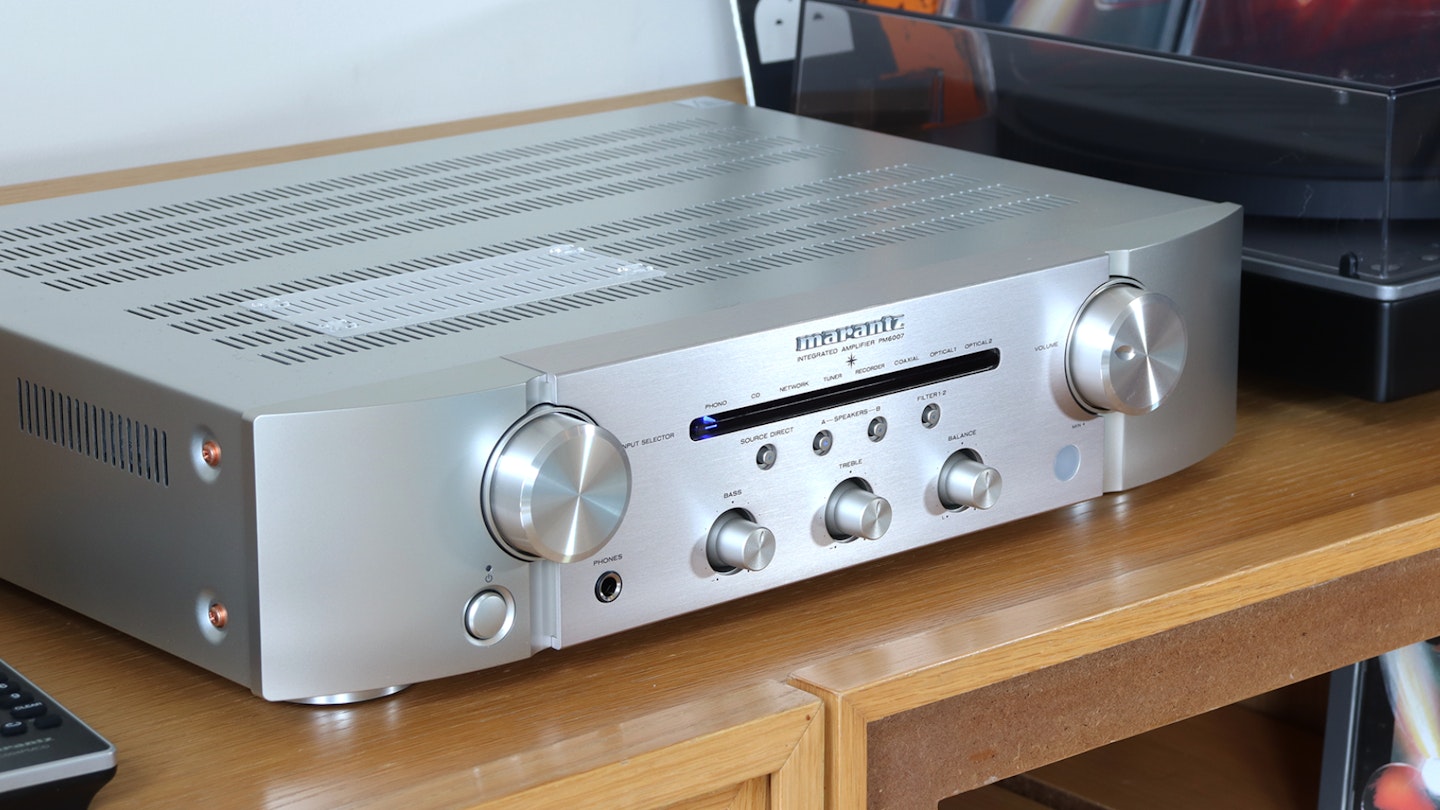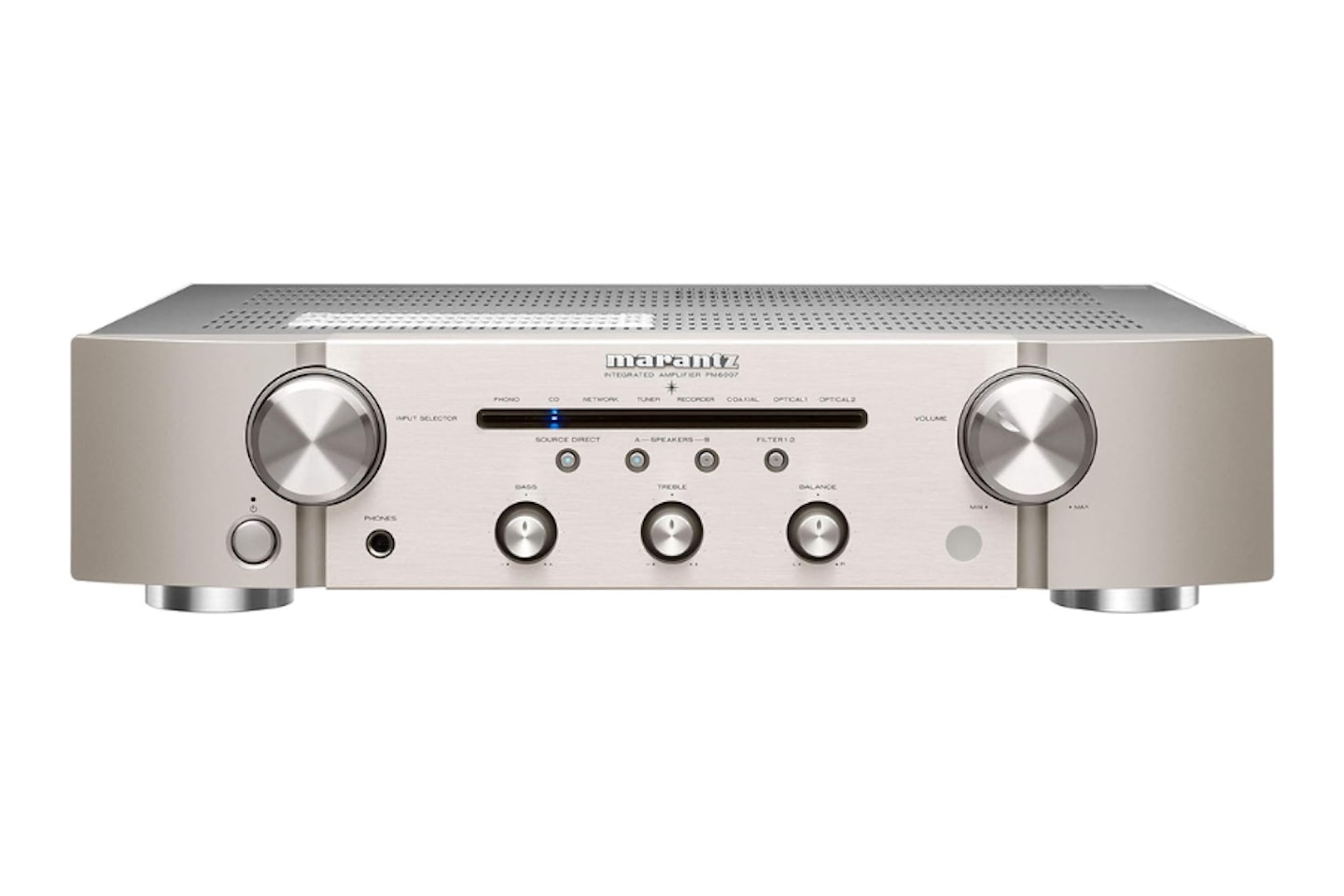The Marantz PM6007 amplifier is just one of a line of hi-fi components that's been around for quite a while now, offering excellent mid-budget and affordable separates to record deck fans, hi-fi newcomers and veterans alike. Somehow, even in a packed marketplace, the Marantz PM6007 amplifier – and the PM6006 before it – always makes it into someone’s top ten for audio gear. It’s also well-lauded for its powerful and well-rounded sound, particularly among rock and metal fans. But, as with all audio tech, beauty is in the ears of the beholder. For every Marantz fan, there’s someone who would rather listen to their tunes on a Denon, and so on.
So, perhaps the best way to settle this once and for all is to put a Marantz PM6007 to the test. Our audio expert, Chris Duffill, has put his vintage NAD setup to one side, dusted off his CDs and shot at his vinyl with an anti-stat gun. Let’s see how the amplifier fared when faced with an unholy mix of techno and metal. Is it really as consummate a performer as people say?
Pros
- Beautifully finished metal facia and simple, logically arranged controls
- Exceptionally well-rounded balanced sound - plenty of precision without sounding harsh
- A full-bodied bass plus warm yet uncluttered mids - works exceptionally well with rock, metal and all guitar-based music
Cons
- No Bluetooth or network-enabled features
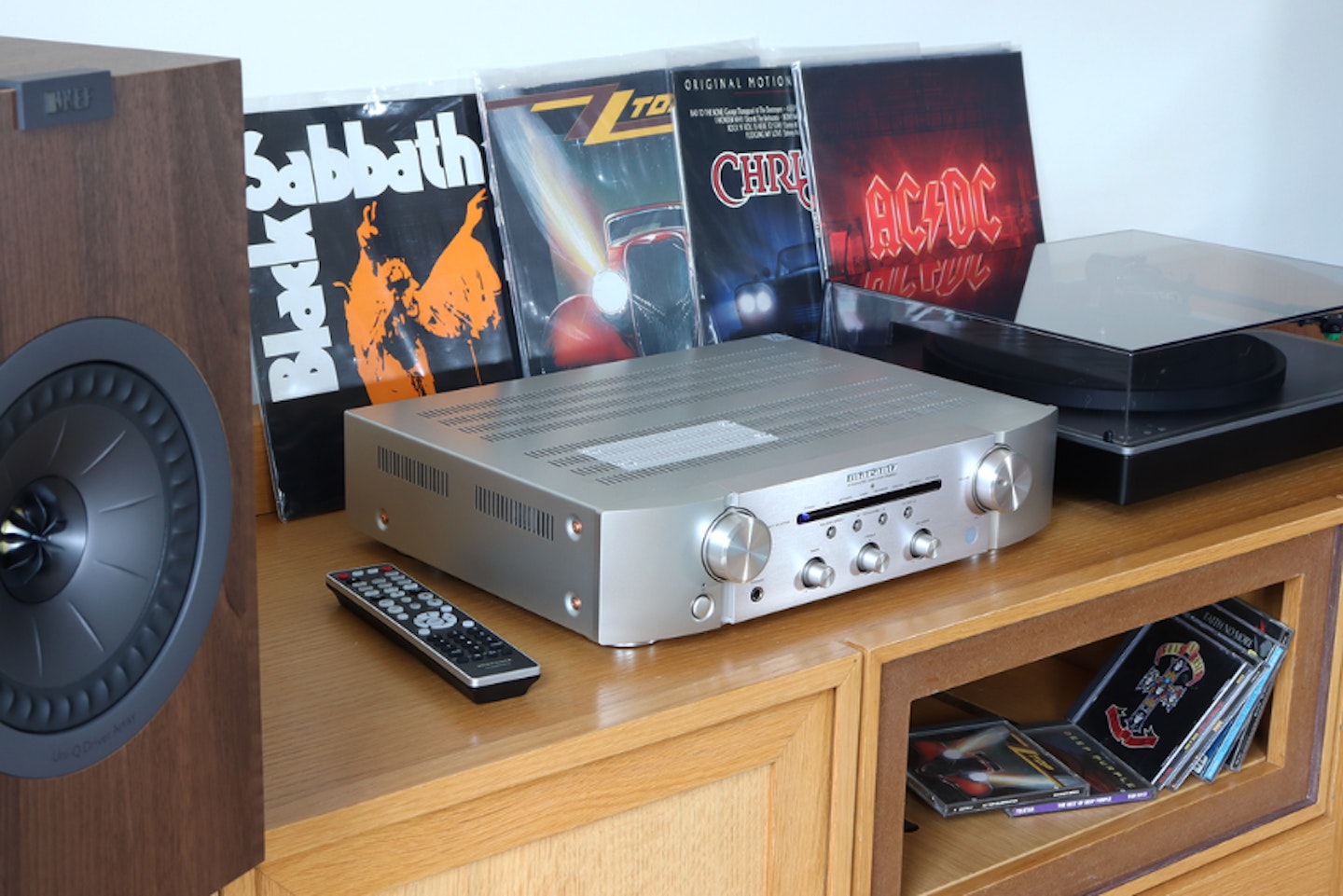
Marantz PM6007: Design and build
Overall
As amplifiers go, I find this Marantz to be very easy on the eye. I chose the brushed silver finish, but the black version isn’t losing any points here either. Personally, I like symmetry when it comes to hi-fi design – and this one is a bit of a masterclass in simple, logical design in my book.
Also, I find the overall size of the PM6007 to be pleasingly compact at just 44cm wide. That’s neat, while still being substantial enough to sit well next to other full-size components. There’s that signature Marantz curved profile at the outer edges – clearly designed to stand out from the competition in an understated way, and also to look neat in a stack of other Marantz components.
I find the design of the remote to be satisfying to handle. It's a no-nonsense remote with a well-balanced set of essential functions and a few extras to keep things usable.
The front panel
In between the two main dial controls for input selection and volume lie the tone controls, plus some extras for the source, speaker selection and filter. I particularly like the tinted strip with the blue LED indicator behind it to indicate the current source. The labelling is easy to read and the position of the LED makes it possible to tell which source is selected from some distance. There’s also a 6.35mm headphone jack for those hefty over-ear cans and of course the power button.
And those control dials feel solid, with both stepped and smooth movements for the sounds and volume respectively. Unlike many silver or metallic finishes, there’s a lot of visual consistency between materials – with the controls well-matched to the fascia panel itself.

Marantz PM6007: Setup
And now to the business end of the Marantz PM6007. For an amplifier this compact, it comes with an excellent array of inputs and speaker connection options. Before I got to plugging things in, I noticed the well-marked input and output groupings on the back panel. Invariably, I’ll end up trying to plug something new into the back late one evening without proper lighting – and these white-on-black labels are very clear to read.
Inputs
Aside from the phono input and ground pin for a record deck, the Audio In section caters for four inputs using RCA: CD, Network, Tuner and Recorder. Obviously, you can plug whatever you like into these – I connected my Majority Fitzwilliam II media player for testing. The phono input actually connects to an internal phono preamp – ideal for anyone with a deck without a built-in preamp.
Elsewhere we have the usual mix of optical and coaxial for digital audio, and a remote control RCA input for passing through remote commands to other compatible components.
Outputs
Audio outputs are a little thin on the ground, but I find this to be perfectly adequate given the size of the amp as a whole. We have an RCA out to a recording device and a subwoofer output for those who want to beef up that bass.
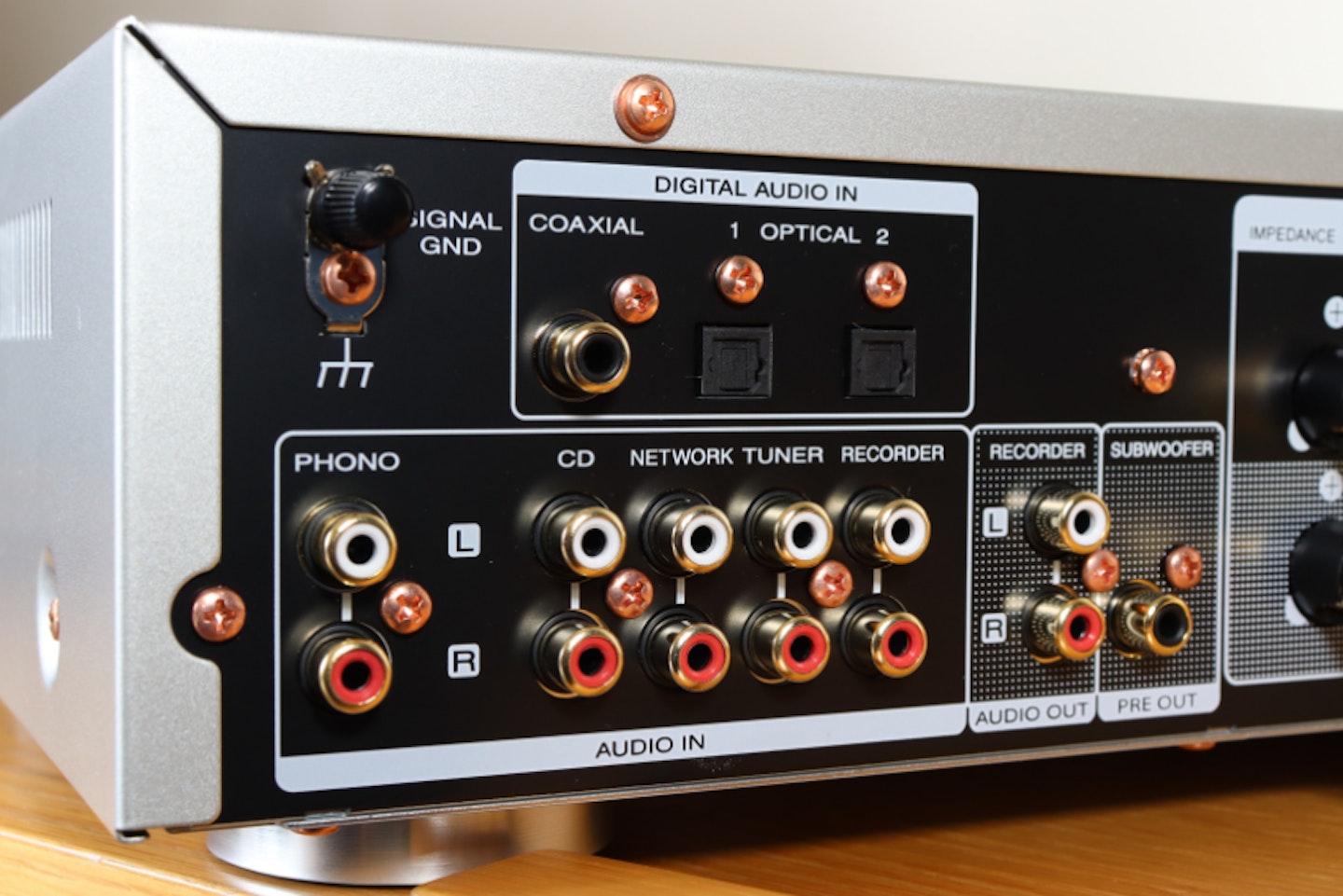
Speaker options
I’m testing this in a standard configuration with a single stereo pair. Each output will kick out 45 watts with a frequency response of 10Hz-70kHz. When researching the best speakers for vinyl, KEFs always wind up on a recommended list, so I connected my KEF Q350 bookshelf speakers (mounted on Atacama stands). The wire is QED Performance Micro Speaker Cable – a solid beginner's wiring choice for this size speaker. I’m also using gold-plated banana plugs – they’re actually a very affordable option. I prefer them over fiddling around with screwing terminals onto bare wires - and they’re also safer if you want to avoid an amp-destroying short circuit.
Although the Marantz PM6007 supports two sets of stereo speakers connected in parallel across A and B outputs, I’m not using that here. The same goes for the bi-wired option. Although I won’t be testing either, I am glad they’re still an option. For the curious, bi-wiring is just how it sounds. Using two sets of wires to connect outputs A and B to the high and low inputs of just one speaker, the amp can then provide more juice to each discrete speaker section. Many advocates claim a more precise sound and elevated mids. Connected speakers need to be bi-wirable, and their jumper bars will need to be removed. So, it’s not for the faint-hearted or anyone just setting out with an entry-level amp.
Subwoofer output
But back to that subwoofer output I mentioned earlier. This is one feature I’m especially happy to see on the Marantz PM6007 is the subwoofer pre-out. In previous years, many of the amps I’ve set up have either had no sub output, or they’d be home-cinema AV amps with dedicated settings for large subwoofers. Here we have the best of both worlds for anyone looking to amp up those super-low bass tones without needing an oversized amp or even a large sub.
According to the manual, the PM6007 isn’t fussy about what kit can be connected to this unassuming sub-output. The sub-out has a fixed low-pass cut-off at 150hz though, so don’t expect any AV-amp style control over how low those sub frequencies can go.

The sound
Digital input test
I decided to test the digital inputs with my CD player via optical cable. Knowing that the Marantz PM6007 has a well-respected internal DAC (Digital to Analogue Converter) I was keen to see how natural the sound might be from the CD player input. And I wasn’t disappointed.
Throwing Excel by 808 State into the tray, I was prepared for some serious bass and electronic highs. I was expecting some of that binary harshness to remain – after all, it goes hand in hand with electronic and dance music, but here the PM6007’s DAC took the edge off. It was particularly noticeable with the track Techno Bell with its high-frequency samples. This DAC includes two filters to choose from for a sharper or slower roll-off too.
Switching to something less precise, I put Deep Purple In Rock on next – and the first track, Speed King. Somehow the DAC really did make this come alive for me. It’s a typical Deep Purple track of the era, with a heavy blend of guitars, bass, drums and high hats. An aggressive DAC might have muddied this sound, but instead, it was very well-tuned – just enough precision and warmth to make it sound natural.
Analogue input test
With my Fitzwilliam II set to internet radio, and the unit connected to the Tuner RCA input, I set about listening to the amp in the way that the majority of owners will: via the analogue inputs. Clearly, this isn’t as pure as a test could be here, as the starting point for internet radio is of course digital, but this is still typical for most users. As expected, the offerings of Planet Rock were reproduced extremely well – despite the compression of all internet radio. If anything, I felt the PM6007 flattened out some of the harshness I’d become used to from the internet radio.
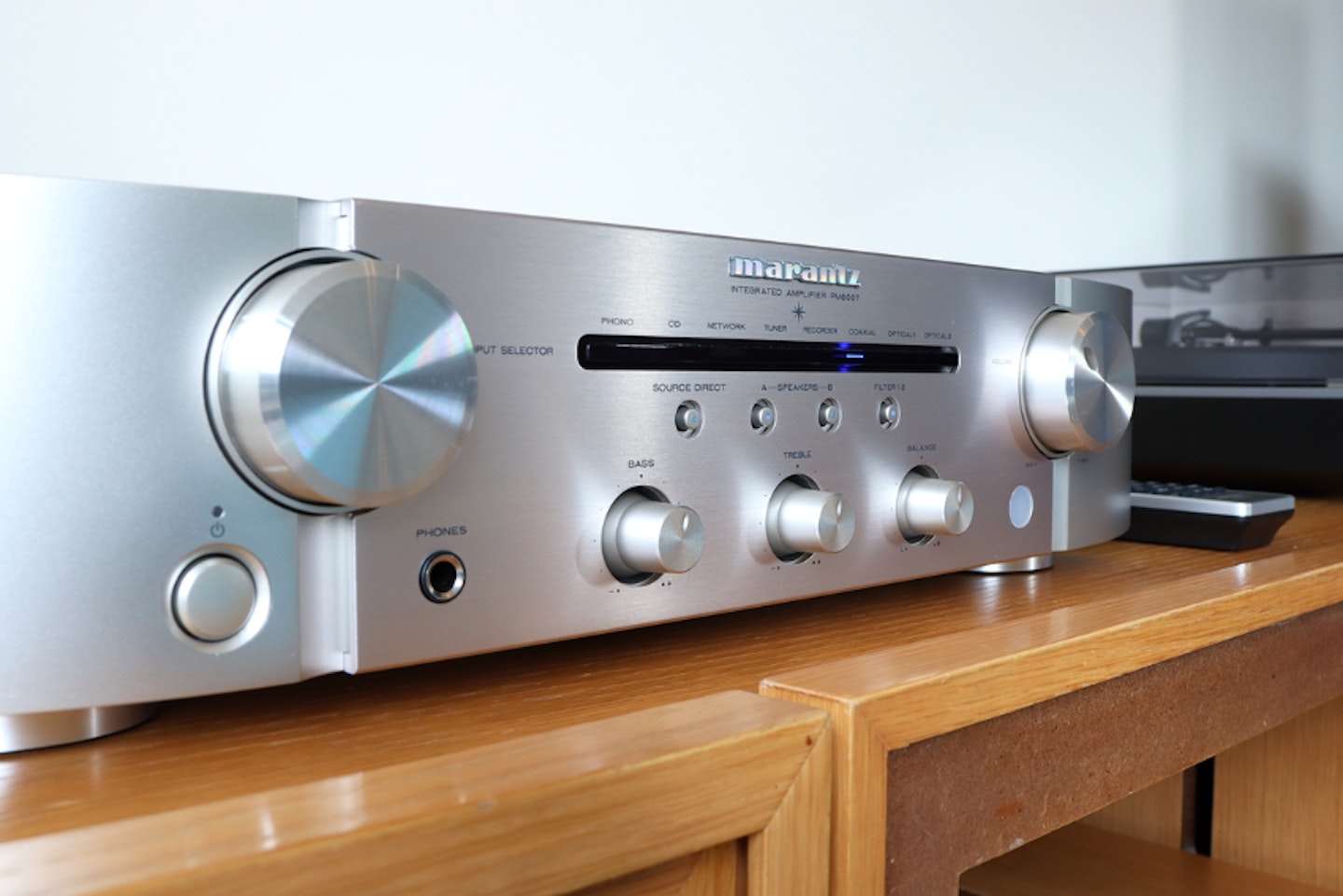
Phono input test
The built-in phono preamp on the Marantz is for Moving Magnet (MM) cartridges only. For me, this is no problem – especially as MM is regarded as the most accessible of the two. An MC (Magnetic Coil) cartridge has a much lower signal level and a precision that appeals to audiophiles. But, they are very expensive, require an exacting setup, and need a preamp with a higher gain level thanks to the lower output. I think Marantz has carefully chosen where to focus the cost of the build here.
Having connected the Cambridge Audio Alva ST that I reviewed to the phono input (first making sure the deck’s built-in preamp was turned off), I placed AC/DC Power Up on the platter and dropped the needle. So, having already been impressed by the Cambridge Audio deck, it was no surprise to find the sound refined, balanced and yet with plenty of midrange grunt – part of the soundstage I often find lacking in cheaper amplifiers. Of course, one caveat here is that a bad deck on a good amp will sound bad, and vice versa.
But, to my ear, the phono input of the Marantz PM6007 is even better than the other inputs – including audio that’s gone through the DAC. It has a brilliant blend of warmth and punchiness – bringing precision to an album like New Order’s Technique, and weight to the bass guitar on Black Sabbath’s Psychonaut. The higher frequencies fare well too, with plenty of detail at the top end. It made me glad I'd opened my record storage crate up again after a bit of a break in my listening.
I was, though, thankful for those accessible tone controls on the front panel – adjusting bass and treble is a must for this amp. While some amplifiers get up to all sorts of internal processing to optimise the output, I’m glad that this amp needs a bit more manual finesse. I like the fact that the default output of the Marantz sounds balanced in an unadulterated way – leaving me to make simple adjustments to suit whatever I’m listening to.

Any negatives?
Keeping in mind that this is Marantz’s ‘entry-level’ offering, it’s genuinely difficult to pick fault with it. Any shortcomings I can muster up only result from the price point rather than glaring omissions for an amp under the £500 mark.
I would have liked to have seen an extra RCA audio output which would have allowed me to have a minidisc recorder as well as a reel-to-reel attached at once. Although Marantz make a network-enabled version, I do wish that they had managed to at least cram Bluetooth connectivity into this one.
Cosmetically, it has a beautiful finish and clean lines – marred only by the flat semi-transparent plastic plate that’s clipped to the top grille. This isn’t easily removed and, having Googled a few forums, it seems this is a heat shield above the amp coil – it definitely looks like an engineering afterthought to appease health and safety types. That said, it’s not too noticeable and you won’t see it at all if the amp is inside a unit or part of a stack.
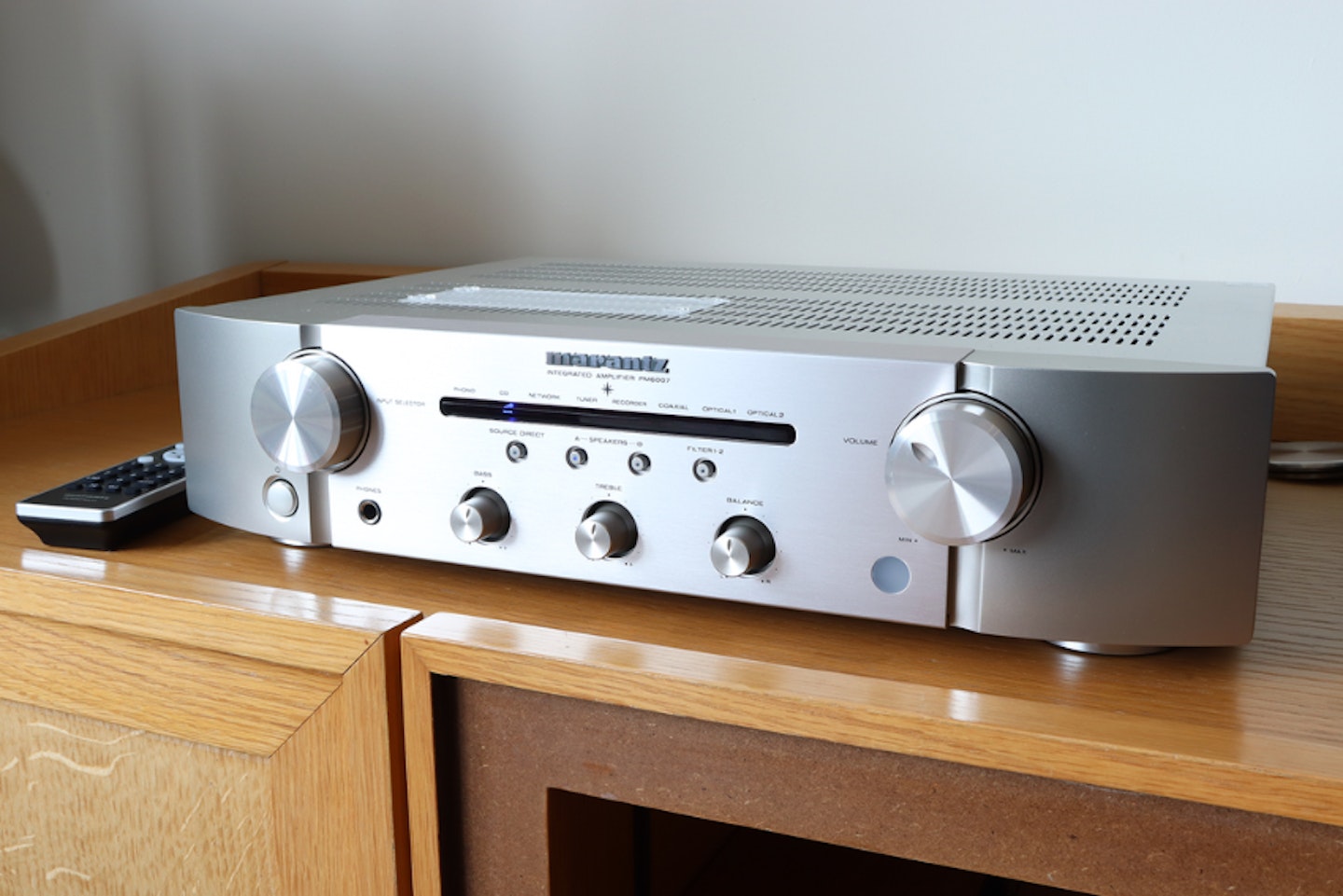
Verdict
One of the reasons I bought the PM6007 was its near-legendary reputation amongst rock and metal fans. And I can see why. The amplifier piped out the sort of well-rounded sound I’d been looking forward to. And that goes for digital and analogue inputs. That internal DAC has a well-earned reputation for smoothing things out, and the overall listening experience I had with this amplifier was extremely satisfying. It's up there with some of the best stereo amps for turntables in my opinion, in this price range.
It looks the part too, sitting well amongst components from other brands without too many controls to over-complicate your setup. The price point is just as impressive – it’s hard to imagine spending this little on an amp that sounds as balanced and powerful as this one. As a consummate performer across various musical genres with enough power to shake the furniture, the Marantz PM6007 earns the right to rest on some well-earned laurels.
Pros
- Beautifully finished metal facia and simple, logically arranged controls
- Exceptionally well-rounded balanced sound - plenty of precision without sounding harsh
- A full-bodied bass plus warm yet uncluttered mids - works exceptionally well with rock, metal and all guitar-based music
Cons
- No Bluetooth or network-enabled features
Chris Duffill is a Tech Product Writer for What's The Best and Yours. His background includes writing, editorial, marketing, design, video production and photography.
He specialises in home entertainment and audiovisual tech, including speakers, amplifiers, turntables, streaming media players, and TVs. He is also one of our resident experts in computing (PCs, tablets, smartphones, smartwatches), DSLR photography and all kinds of digital cameras. He also writes about retro gaming, game consoles and various electronic gadgets. If it plugs in, lights up or makes a noise, he’ll write about it.
Subscribe to the What’s The Best Newsletter to keep up to date with more of the latest reviews and recommendations from the rest of the What’s The Best team.
